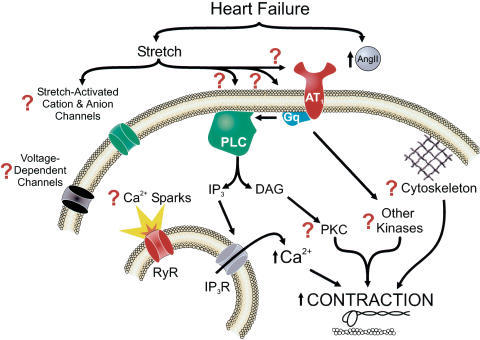Figure 2.
Signaling pathways potentially involved in altered AT1 receptor function and enhanced myogenic reactivity in CHF. Evidence provided by Gschwend et al. (2003) suggests that myogenic constriction is enhanced in heart failure and appears to be linked to altered AT1 receptor function. These authors suggest that preformed and stored Ang II is released and local elevated Ang II levels increase myogenic tone. An alternative hypothesis is that the AT1 receptor itself, its coupling to Gq and/or phospholipase C (PLC) is (are) modified in heart failure leading to constitutive activation of this pathway. Future studies should be designed to investigate the possible role of downstream events such as smooth muscle membrane potential, voltage-dependent and stretch-activated cation and anion channels, mechanisms regulating global intracellular Ca2+ levels, the ryanodine receptor (RyR) which is responsible for generating Ca2+ sparks and inositol-tris-phosphate (IP3)-Ca2+ release channels, protein kinase C (PKC) and other kinases (Rho, Ras, MAPK, Erk, etc.), cytoskeletal and contractile proteins, all of which have been implicated to play role in generating myogenic tone (Davis & Hill, 1999).

